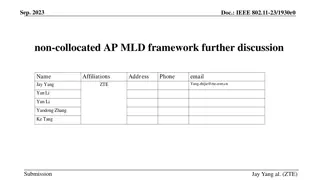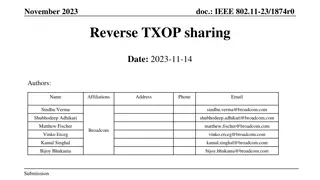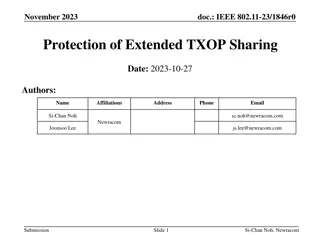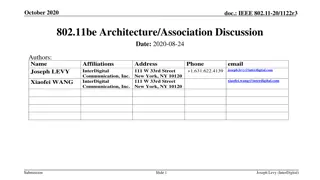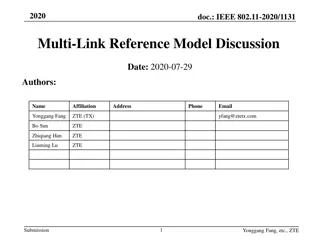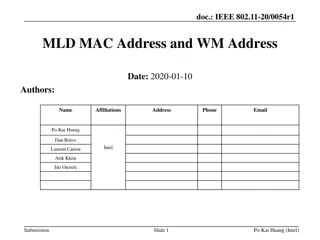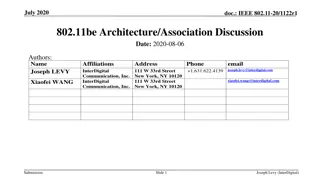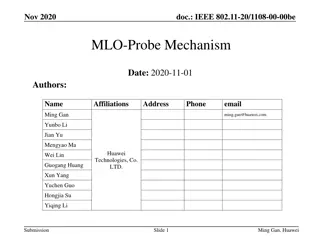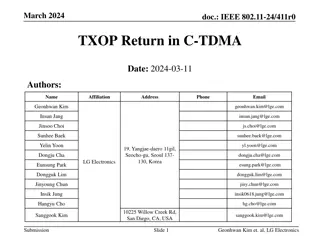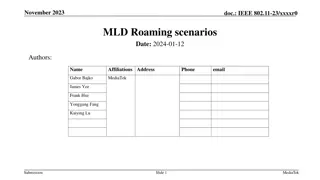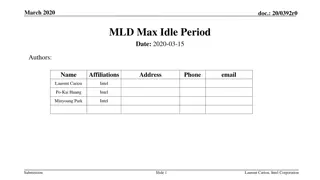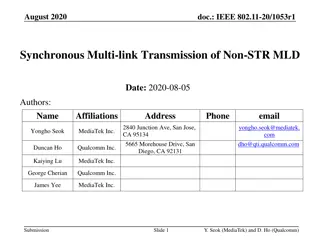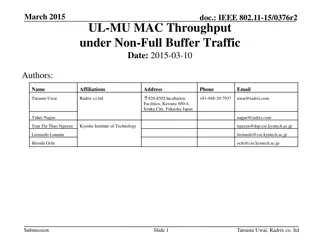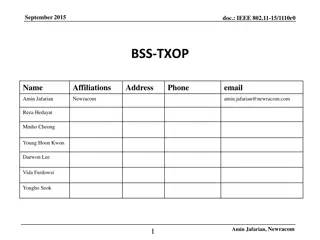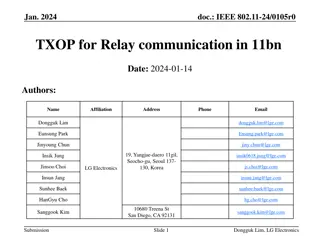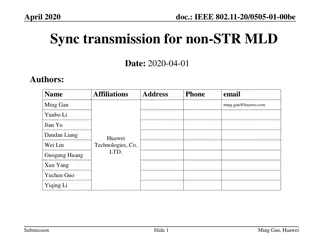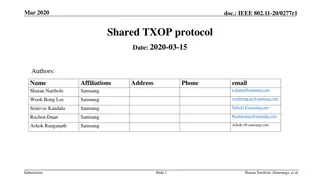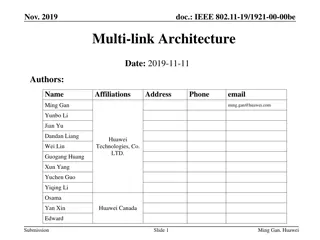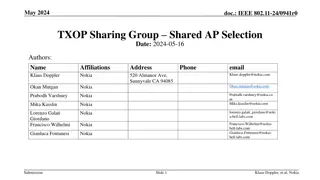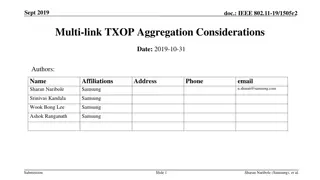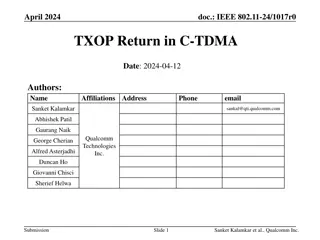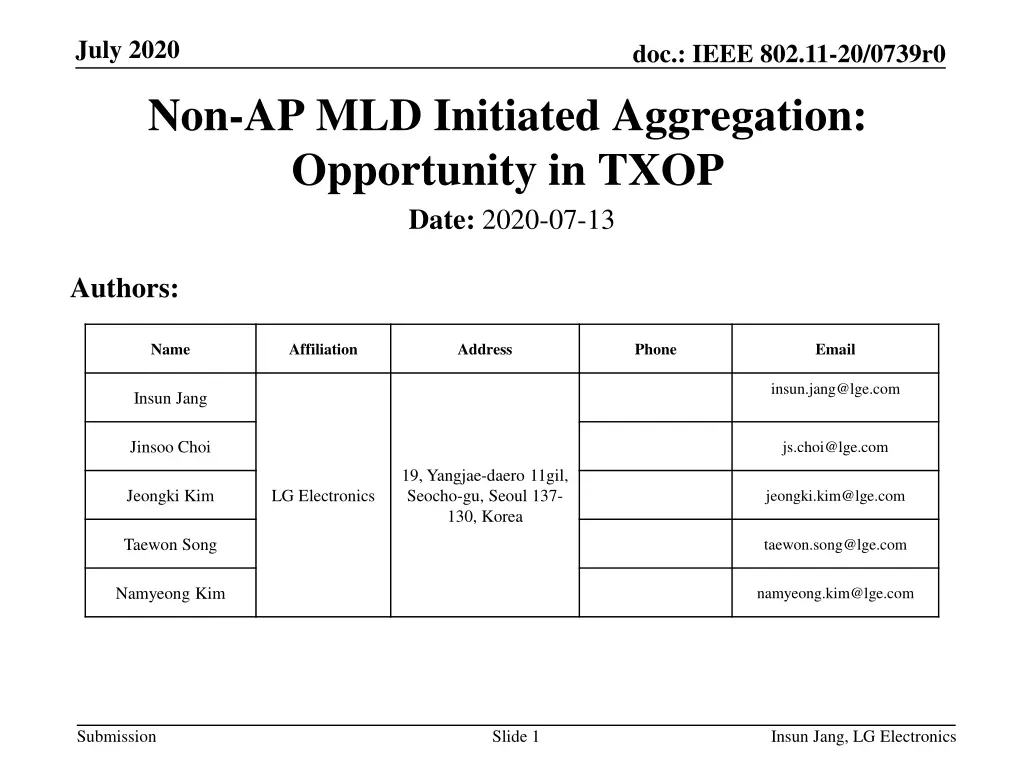
IEEE 802.11-20/0739r0 Non-AP MLD UL Aggregation Opportunity
"Explore UL aggregation methods for non-AP MLD in IEEE 802.11-20/0739r0, discussing scenarios and possible options during TXOP for aligning PPDUs on multiple links. Consider opportunities for power saving and efficient channel access."
Download Presentation

Please find below an Image/Link to download the presentation.
The content on the website is provided AS IS for your information and personal use only. It may not be sold, licensed, or shared on other websites without obtaining consent from the author. If you encounter any issues during the download, it is possible that the publisher has removed the file from their server.
You are allowed to download the files provided on this website for personal or commercial use, subject to the condition that they are used lawfully. All files are the property of their respective owners.
The content on the website is provided AS IS for your information and personal use only. It may not be sold, licensed, or shared on other websites without obtaining consent from the author.
E N D
Presentation Transcript
July 2020 doc.: IEEE 802.11-20/0739r0 Non-AP MLD Initiated Aggregation: Opportunity in TXOP Date: 2020-07-13 Authors: Name Affiliation Address Phone Email insun.jang@lge.com Insun Jang Jinsoo Choi js.choi@lge.com 19, Yangjae-daero 11gil, Seocho-gu, Seoul 137- 130, Korea Jeongki Kim LG Electronics jeongki.kim@lge.com Taewon Song taewon.song@lge.com Namyeong Kim namyeong.kim@lge.com Submission Slide 1 Insun Jang, LG Electronics
July 2020 doc.: IEEE 802.11-20/0739r0 Introduction Many contributions [1]-[8] have addressed how to transmit UL PPDUs on multiple links simultaneously for non-STR non-AP MLD In this contribution, we discuss another method for a constrained non-AP MLD to aggregate links during TXOP(s) It can follow an existing EDCA rules with an additional rule Submission Slide 2 Insun Jang, LG Electronics
July 2020 doc.: IEEE 802.11-20/0739r0 UL Aggregation of Non-STR Non-AP MLD Basically, UL aggregation means aligning starting times and ending times of PPDUs that are sent simultaneously on multiple links Several Scenarios No Aggregation: It may provide opportunities of power saving [9] When gaining a channel access After gaining a channel access, i.e., during TXOP (focus) Submission Slide 3 Insun Jang, LG Electronics
July 2020 doc.: IEEE 802.11-20/0739r0 Observation on TXOP with Non-STR On Link 2 At TX Phase on link 1 In most cases, back-off counter (BC) wouldn t decrease due to strong in-device (self) interference It always may set the channel state to BUSY, which cannot decrease BC On Link 2 At RX Phase* on link 1 BC can decrease by following existing EDCA rules without the inference NAVSyncDelay could be also considered If BC = 0, STA 2 cannot transmit a PPDU during RX phase on link 1 How can we handle operations on Link 2 at each phase? Submission Slide 4 Insun Jang, LG Electronics
July 2020 doc.: IEEE 802.11-20/0739r0 Possible Options During TXOP Option 1: Defer Channel Access (Not decrease BC) during TXOP It is simple and can have an opportunity to save power during the TXOP [9] However, it can lose an opportunity to transmit frames Option 2: Performs Channel Access during TXOP It just follows the existing EDCA rules During RX phase, if BC = 0? Submission Slide 5 Insun Jang, LG Electronics
July 2020 doc.: IEEE 802.11-20/0739r0 If BC = 0 During RX Phase Option 2-1: Re-pick BC (Not transmit anything) It can avoid non-STR issue However, it can lose an opportunity to transmit frames Option 2-2: Defer during a certain time and Gains a channel access, i.e., transmit a PPDU by aligning it with the PPDU transmitted on TXOP link Normally, it can have an opportunity to transmit frames It needs an additional simple rule We may allow both options in spec Slide 6 Submission Insun Jang, LG Electronics
July 2020 doc.: IEEE 802.11-20/0739r0 Focusing on Option 2-2 A Proposed Rule During a TXOP of an STA of a non-STR non-AP MLD, when another STA of the MLD gains a channel access, the another STA may defer and can transmit a PPDU simultaneously with the next PPDU of STA if medium is IDLE Medium sensing duration is the interval of TBD (e.g., PIFS, aSlotTime) immediately preceding the start of next PPDU duration Starting and Ending times of the PPDUs are aligned with TBD margin The STA needs to know the length and starting and ending times of a PPDU to be transmitted by other STA(s) Slide 7 Submission Insun Jang, LG Electronics
July 2020 doc.: IEEE 802.11-20/0739r0 Discussion on Sensing Duration Some scenarios During PIFS or less than PIFS (e.g., SIFS, aSlotTime), STA 2 may not be able to detect any frames, e.g., STA 2 will recognize channel is IDLE We think it would be good to perform CCA during Whole time for reliability (at the expense of efficiency) Submission Slide 8 Insun Jang, LG Electronics
July 2020 doc.: IEEE 802.11-20/0739r0 Summary We observed TXOP with non-STR As a result, we can allow an UL aggregation with a slight change of existing rules Specifically, we proposed a rule, During a TXOP of an STA of a non-STR non-AP MLD, when another STA of the MLD gains a channel access, the another STA may defer and can transmit a PPDU simultaneously with the next PPDU of STA if medium is IDLE Medium sensing duration is the interval of TBD immediately preceding the start of next PPDU duration For example, the interval can be time elapsed from BC = 0 until the start of next PPDU or PIFS Starting and Ending times of the PPDUs are aligned with TBD margin Submission Slide 9 Insun Jang, LG Electronics
July 2020 doc.: IEEE 802.11-20/0739r0 SP #1 Do you agree that 11be shall define mechanism(s) for enabling a non-AP MLD with constraints to transmit PPDUs simultaneously on multiple links by aligning starting times and ending times of the PPDUs? NOTE: The differences between starting or ending times have the value of more than 0 Y/N/A Submission Slide 10 Insun Jang, LG Electronics
July 2020 doc.: IEEE 802.11-20/0739r0 SP #2 Do you agree that 11be shall define the following operation for non-STR During a TXOP of an STA of a non-STR non-AP MLD, when another STA of the MLD gains a channel access, the another STA may defer and can transmit a PPDU simultaneously with the next PPDU of STA if medium is IDLE Medium sensing duration is the interval of TBD immediately preceding the start of next PPDU duration For example, the interval can be time elapsed from BC = 0 until the start of next PPDU or PIFS Starting and Ending times of the PPDUs are aligned with TBD margin Y/N/A Submission Slide 11 Insun Jang, LG Electronics
July 2020 doc.: IEEE 802.11-20/0739r0 Appendix: BA Duration in 11be Duration of RX Phase Expected Time: 2 SIFS * + Compressed BA duration Assuming Data rate 7.3Mbps (MCS 0, 1x1 SS, 20MHz in 11ax) Case 1: 256 bitmap => 93.4us Case 2: 512 bitmap => 128.4us Case 3: 1024 bitmap => 198.6us Submission Slide 12 Insun Jang, LG Electronics
July 2020 doc.: IEEE 802.11-20/0739r0 Back-up: UL Aggregation (Non-STR) [2] Basically, UL aggregation means aligning start/end of UL PPDUs that are sent simultaneously on multiple links The initiator of transmission is non-STR non-AP MLD Non-AP Initiated Aggregation (e.g., Truncation of BC [1]-[5], [8]) AP-assisted Aggregation [2], [6], [7] Example: Request and Response for Aggregation [1] Submission Slide 13 Insun Jang, LG Electronics
July 2020 doc.: IEEE 802.11-20/0739r0 References [1] 802.11-19/1144r6 Channel Access for Multi-link Operation [2] 802.11-20/0414r4 Method for Handling Constrained MLD [3] 802.11-20/0026r7 MLO: Sync PPDUs [4] 802.11-20/0275r2 MLO: Need for sync PPDUs [5] 802.11-20/0487r5 Multiple Link Operation Follow Up [6] 802.11-20/0081r3 MLO-Synch-Transmission [7] 802.11-20/0291r1 MLO a-synchronize and synchronize operation discussions [8] 802.11-20/0577r0 RTS and CTS Procedure in Synchronous Multi-link Operation [9] 802.11-20/0037r1 Power Saving Considering Non-AP without STR Capability Submission Slide 14 Insun Jang, LG Electronics

